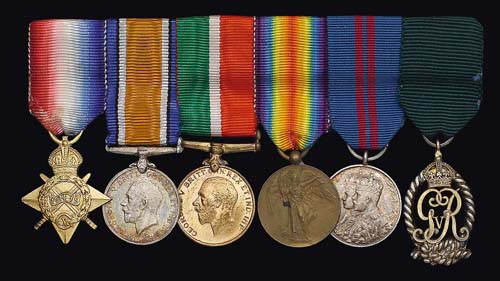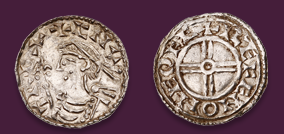
Auction: 11011 - Orders, Decorations, Campaign Medals & Militaria
Lot: 278
Miniature Awards: The Great War Group of Six Attributed to Cunard Liner Captain W.R.D. Irvine, Royal Naval Reserve, Who Was in Command of R.M.S. Laconia When She Was Sunk by a German U-Boat, 25.2.1917, An Act That Hastened the United States´ Declaration of War Against Germany 1914-15 Star; British War Medal; Mercantile Marine War Medal; Victory Medal; Coronation 1911; Royal Naval Reserve Decoration, G.V.R., good very fine, mounted as originally worn, with the following related items: - The recipient´s Waterman´s fountain pen, inscribed ´W.R.D. Irvine R.D., R.N.R.´, in case - Presentation Certificate named to Commander W.R.D. Irvine, R.N.R., given to him by a party of Roman Catholic pilgrims aboard the S.S. Pannonia in appreciation of his ´courtesy and kindness which has brightened our ocean voyage´, and signed by Augustus Van de Vyver, Bishop of Richmond, Virginia, and 121 members of his flock - Various newspaper cuttings regarding the sinking of the Laconia - Two Portrait photographs of the recipient - Various photographs and postcards of the Laconia and a page of the ship´s embossed writing paper - Various miscellaneous buttons (6) Estimate £ 300-400 Captain William Robert Duncan Irvine, R.D., was born in November 1863, and served in the Merchant Navy; he transferred to the Cunard Line in November 1895, and served on the Liverpool-New York run, gaining steady advancement to Chief Officer in the Caronia in February 1905, and to Master of the Veria in September of the same year. Meanwhile, in common with other Mercantile Marine officers, he had been commissioned in the Royal Naval Reserve, gaining experience on assorted R.N. courses and advancement to Lieutenant in August 1899 and to Commander in July 1910. On the outbreak of hostilities in August 1914, Irvine was in command of the S.S. Laconia, which was soon converted into an Armed Merchant Cruiser. The Laconia served in the South Atlantic and in the Indian Ocean, in addition to being employed as a headquarters ship during the operations leading to the capture of Tanga in German East Africa. In July 1916, she was returned to Cunard and resumed her usual cross-Atlantic voyages, work that led to her famous demise on the 25th February 1917, when torpedoed by the U-50 some 160 miles N.W. by W. off the Fastnet - one torpedo having struck the liner at 10.33 p.m. on the starboard side just abaft the engine room, another found its mark in the engine room from point blank range about 30 minutes later, and she sank at 11.45 p.m. The Laconia had 292 persons on board, comprising 34 First Class and 41 Second Class passengers, including women and children, in addition to Irvine and his crew, and of these 12 died, including the American citizens Mrs. Mary Hoy and her daughter Elizabeth, from Chicago - the survivors had to pass several hours in open boats before being picked up by the sloop H.M.S. Laburnum. The death of the Hoys, as vividly reported by one of the survivors, a journalist from the Chicago Tribune, arguably acted as the final catalyst in bringing the United States of America into the War, with the account of the sinking (which made reference to Irvine´s gallant conduct) read from the floor of both houses of Congress. Five weeks later, the United States declared war on Germany. Irvine remained with Cunard for many years, commanding among other vessels the newly launched S.S. Laconia in the 1920s. Captain W.R.D. Irvine´s full sized medals were sold at auction in May 2011 for £3,100.
Sold for
£300




